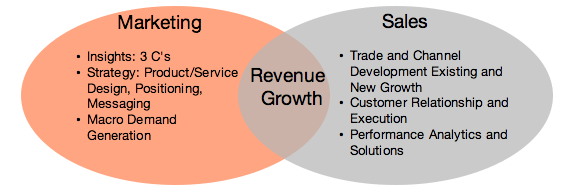
A well-functioning partnership between Marketing and Sales is critical to the growth of any business. But how do you get there and ensure that your efforts are coordinated and that investments in these areas are as efficient and effective as possible? This question is more important than ever as you look to accelerate growth in a challenging market where the margin for error is slim.
Unfortunately, misconceptions, misunderstanding, and mistrust often get in the way of a collaborative relationship.
There is no place or frankly time for the long-held misconceptions about these groups that get in the way of productive, effective relationships. Many still subscribe to the “Mad Men” view of Marketing as a bit “soft,” thinking it is about advertising or packaging/design or purely supporting the Sales Team in an enablement function. That misses the critical role Marketing plays in understanding customer and competitors and how the capabilities of the firm can be focused against the best opportunities for growth. Marketing needs to take the lead in uncovering important customer insights, employing digital tools to reach the best potential buyers, and managing the customer experience across key touchpoints all with a focus on building demand.
And Sales professionals are often viewed as those extroverted hunters whose job it is to wine and dine customers to build relationships and “get” potential customers to buy. That misses the strategic role Sales plays in discovering customer needs, trade and channel development, and leveraging a data driven, solution-oriented approach to help customers solve problems and ultimately guide the buying process.
It is also time to move beyond misunderstanding and mistrust between the two groups, which leads to unproductive adversarial relationships focused on fighting for credit over who is driving sales and revenue for a company.
Come on, it is 2020, we have technology in the form of automation, CRM, SEO, etc. and an associated increase in data has made the classic Marketing and Sales paradigm obsolete. With more information available than ever, the customer is in control of the buyer journey and often does not even connect with a company until they are far along in the process, in many B2B markets 70-80%+ down the funnel. Success means ensuring greater alignment and collaboration between Sales and Marketing with both groups needing to operate in an integrated (and digitally enabled) fashion to manage the sales funnel. It requires a partnership focused on joint accountability and alignment around REVENUE GROWTH plain and simple. The figure below shows how this should work.

 So how do you get there, especially in these challenging times, where framing and activating a growth roadmap for your company is critical if you want to not just survive but thrive. We believe there are three key steps that you need to take to get there and you can make these three critical first steps in 100 days. We call this The Marketing and Sales Accelerator Model. The 3 Step Model is outlined below:
So how do you get there, especially in these challenging times, where framing and activating a growth roadmap for your company is critical if you want to not just survive but thrive. We believe there are three key steps that you need to take to get there and you can make these three critical first steps in 100 days. We call this The Marketing and Sales Accelerator Model. The 3 Step Model is outlined below:
1) Begin by assessing the 3C’s (Customer, Competitors, Context) to uncover new insights and identify market opportunities. Focus on defining who your customers really are and understanding the buying process and sales funnel. Then prioritize customer segments based on size/potential, fit with your brand, degree of difficulty in reaching and converting them, investment required, potential for above average growth, etc.
2) Frame an integrated go to market strategy and narrative that is digitally enabled and grounded in the reality of what it will take to be successful against the identified opportunities. This requires taking a hard look at your current Marketing and Sales capabilities and identifying areas of strength/differentiation, level of integration/coordination, data available, and gaps that need to be addressed to attack the identified market opportunities in a coordinated and efficient fashion.
3) Establish clear success metrics, align Marketing and Sales compensation/incentives and commit to an iterative, data driven go to market approach that drives continuous learning and improvement. You also need to align marketing and sales compensation around revenue growth. While that is usually the case for sales, marketing also needs to have skin in the game and have joint accountability for achieving the revenue goals. The only way you can be successful is to have Marketing and Sales fully aligned around data, goals, and rewards.
Through an “agile like” process leveraging 3 Sprints associated with the above steps, existing company/market data and knowledge resident in the organization, you can make critical decisions and develop the high-level plan necessary to build an integrated and more effective Marketing and Sales strategy. It is designed to give you the roadmap and build the confidence/momentum you need to get in position to commit to activating a plan and make the Marketing and Sales investments required to achieve your revenue ambitions.
About the Co-author:
John Baglivo, CMO, Chief Outsiders
An experienced global chief marketing officer with deep B2B and B2C experience and a proven record of success, John helps CEOs accelerate growth by better understanding their customers, defining more relevant and compelling products and services, building effective marketing strategies and organizations and crafting digitally enabled go-to-market plans. A seasoned executive and consultant with an analytical but pragmatic approach, John unlocks growth by bridging customer centered strategy with effective operational execution.
Contact John at 847-909-6856 or [email protected].
Related posts:
No related posts.

